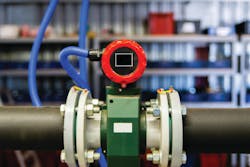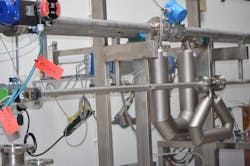Even though we cannot see them, gases are all around us. Gases are distinguished according to their different atomic configurations. While there are some “pure” gases, like hydrogen and oxygen, there are also many gas mixtures. Some are simply combinations of different atoms into molecules such as carbon dioxide (CO2) and water (H2O). The air we breathe is a mixture of gases — primarily nitrogen, oxygen and argon, along with some other trace gases. Some mixtures of oxygen, nitrogen and carbon dioxide are used to delay food spoilage and increase shelf life.
Industrial gases are specific types of gases that are gaseous at ambient pressure and temperature and are specifically manufactured for use in industry. Any gas that is put in a canister is considered an industrial gas, with the exception of certain fuel gases. In fact, industrial gases are typically put into canisters or cylinders and sold for use in that form. Some of the better-known companies that manufacture industrial gases include Air Liquide, Air Products & Chemicals, The Linde Group, Nippon Gases, and Praxair.
The U.S. Energy Information Administration (EIA) defines natural gas as “a gaseous mixture of hydrocarbon compounds, the primary one being methane.” Natural gas is called “natural” because it occurs in nature. In fact, its occurrence in nature is always underground, whether it is under land or under water. Some natural gas occurs deep below the ocean depths, and this has led to the development of advanced drilling involving subsea technology.
Like oil, natural gas developed over millions of years as a result of the decay of millions of microorganisms. Both natural gas and oil were created over vast amounts of time as a result of the combination of temperature and pressures on these microorganisms. It is unfortunate that we are using up these vast resources that took millions of years to develop in the course of several hundred years. Fortunately, many companies have turned to renewable fuels as an alternative source of energy. These may not replace oil and gas, but they will allow them to survive for use by future generations for applications that cannot be satisfied by renewable energy.
Gas flow measurement
Flowmeters are sometimes divided into new technology and conventional meters. New-technology meters were introduced after 1950 and are generally the focus of product development more than conventional meters. Conventional meters have been around much longer than new-technology meters, but as a result, have a large installed base. Unlike new-technology flowmeters, most conventional meters have moving parts. There is a gradual shift from conventional to new-technology meters in the market, including the market for gas flow measurement.
Coriolis
Coriolis flowmeters operate by measuring the degree to which fluid momentum causes a vibrating tube to deflect. This enables Coriolis meters to measure liquids better than gases, since liquids are denser than gases. Coriolis meters are widely used in refineries and petrochemical plants and for downstream applications. They are used to measure billing and custody transfer applications of refined petroleum products. Here, they compete with positive displacement meters.
Ultrasonic
Ultrasonic flowmeters are widely used for gas flow measurement. Inline models send an ultrasonic signal from one side of the pipe to the other and then send a signal in the reverse direction. When the signal travels with the flow, it moves more quickly than when it travels against the flow. Ultrasonic flowmeters measure the transit time of the signal in each direction, with the flow and against the flow. Flow rate is proportional to the difference in these two transit times.
Ultrasonic flowmeters are one of the three main types of flowmeters used for custody transfer of natural gas. In this area, they compete against differential pressure and turbine flowmeters. In 1998, ultrasonic flowmeters received the approval of the American Gas Association (AGA) for use in custody transfer applications. Ultrasonic flowmeters used for custody-transfer of natural gas must have at least three paths due to the high accuracy required. Some now have as many as 12 paths. The most common multipath meters have four, five or six paths; although, some companies also make eight-path and 12-path meters. Suppliers of multipath flowmeters include Emerson Daniel, Honeywell/Elster, SICK, TechnipFMC, KROHNE, and Sensia (formerly Cameron Measurement Systems).
Vortex
Vortex meters measure flow by placing a bluff body in the fluid and then counting the vortices that the bluff body generates. They are among the most versatile meters in that they can measure liquid, gas and steam with equal ease. Vortex meters are widely used for steam flow measurement since they can tolerate both the high temperature and high pressure of steam applications. This makes them popular in the power industry, but they are also used in the oil and gas, refining, chemical and other process industries.
Thermal
Thermal flowmeters are used almost exclusively to measure gas flow. Thermal flowmeters typically inject heat into the flow stream and then measure how quickly this heat dissipates. This value is proportional to mass flow. Two different technologies for thermal measurement are constant power and constant temperature. One main application for thermal flowmeters is measuring stack gas flows. In the early 1990s, the U.S. Environmental Protection Agency (EPA) requirements created a need to measure sulfur dioxide (SO2), nitrous oxide (N2O) and other industrial pollutants emitted from smokestacks. Due to the large size of these stacks, multiple measuring points were necessary for accurate measurement. Multipoint thermal flowmeters were developed in response to this requirement. Today, a broader need to measure greenhouse gas emissions is generating added momentum in the thermal flowmeter market.
Conventional flowmeters
Differential pressure and primary elements
Differential pressure (DP) flow technology has been around for more than 100 years. DP flowmeters require the presence of a constriction in the line to create a difference in upstream and downstream pressures. The device that creates this constriction is called a primary element. A DP flowmeter consists of a differential pressure transmitter integrated with a primary element.
There are many types of primary elements, and each is suited for a particular application. The most popular type of primary element is an orifice plate, which is a round metal plate with one or more holes in it. Other types of primary elements include Venturi tubes, Pitot tubes, flow nozzles and wedge elements. Just as ultrasonic flowmeter suppliers have developed multipath ultrasonic flowmeters for custody transfer applications, DP flowmeter suppliers have developed single- and dual-chamber orifice fittings for custody transfer. Dual-chamber orifices are designed to allow the inspection or replacement of the orifice plate without shutting down a process line.
Positive displacement
Positive displacement flowmeters work by capturing the flow in small compartments and then counting how often this is done. Flow rate is calculated based on the number of times these compartments are filled and emptied. The main types of positive displacement flowmeters are oval gear, rotary, piston, nutating disc, diaphragm and helical. Positive displacement meters are for residential, commercial and industrial applications. They are widely used in utility gas flow measurement. Here, they face competition from turbine flowmeters. However, positive displacement meters excel at measuring low flow rates, and they do best in line sizes of 10 inches or less. Both diaphragm and rotary meters are widely used for gas flow measurement. While new-technology flowmeters, such as Coriolis, are beginning to make an impact on the gas utility market, in many cases, they do not yet have the necessary industry approvals to allow them to be widely used for these applications.
Turbine
Turbine meters measure flow with a spinning rotor that spins in proportion to flow rate. They are approved for custody transfer of both natural gas and petroleum liquids. Like ultrasonic meters, they come in large line sizes of up to 42 inches and above. Both turbine and ultrasonic meters excel in measuring high-speed gas flows, and both are widely used to measure the flow in large natural gas pipelines. Here, ultrasonic meters are gaining an advantage because they do not have moving parts. The rotor in turbine meters is a mechanical device that is subject to wear. It can also be knocked out of calibration by impurities in the flow stream.
Like DP flowmeters, turbine flowmeters have been around for many years. They are widely used for liquid and gas flow measurement but cannot be used to measure steam flow. Turbine flowmeters excel at measuring clean, steady and medium- to high-speed flows of low-viscosity fluids. Turbine flowmeters are the third main type of flowmeter used for custody transfer of natural gas.
The future looks bright for gas
While gas is a fossil fuel, there is a long-term trend away from coal and crude oil as energy sources and toward natural gas. The reason is that natural gas burns cleaner than coal, crude oil and refined fuels, and environmental concerns have become paramount in the midst of perceived climate change. While many people view solar, wind and other renewable sources of energy as the long-term solution to our energy problems, the road to these desirable solutions winds through natural gas. For this reason, the need for gas flow measurement will be around for a long time, which is a trend that will benefit suppliers of gas flowmeters.
Jesse Yoder, Ph.D., is president of Flow Research Inc. He has 30 years of experience as an analyst and writer in instrumentation. Yoder holds two U.S. patents on a dual-tube meter design and is the author of "The Tao of Measurement," published by ISA. He may be reached at [email protected]. Find more information on the latest study from Flow Research, "The World Market for Gas Flow Measurement, 4th Edition," at www.gasflows.com.



